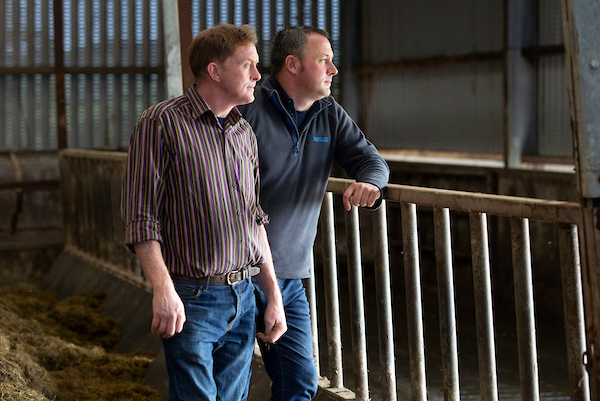Millands Farm: Using metabolic profiling to improve efficiency and maximise output
Wednesday, 31 May 2023
Wallace and James Hendrie are always looking for ways to improve efficiency and maximise output. As part of AHDB’s strategic dairy farm programme, the team identified fertility as a significant challenge and have been exploring a range of options to improve the performance of the herd.
Based in Ayrshire, the brothers run their 620 Holstein Friesian herd across two farms, Millands and Netherlands. The spring block calving herd are milked twice a day in 26 and 24 swing-over parlours, producing an average 5,750 litres per year with 4.2% fat and 3.5% protein.
Battling Scottish weather, the herds are usually housed between mid-October and mid-March with Wallace keen to get the cows out as soon as the weather allows in the spring. Millands stretches to 235 ha of long-term leys with a further 110 ha available at Netherlands.
In 2022 the herd had a 59% conception rate, close to the target 60%, and an 86% final in-calf rate with a target of 90%. However, as block calvers, Wallace and James are particularly keen to improve the six week in-calf rate, which was at 78% against the target of 85%.
As part of their bid to reach these targets, the team have been working with their own vet, Alan Walker, Armour Vet Group, and Alastair Macrae, University of Edinburgh. By blood testing selected cows in the herd and analysing the results, they are able to make small changes to cow diet and management and are starting to see the positive results.
Metabolic profiling
“Metabolic profiling can be an efficient and helpful tool to assess the nutritional and health status of your herd,” says Doreen Anderson, Senior Knowledge Exchange Manager, AHDB, who has been working with Wallace for the past two years. “It consists of blood testing cows within representative groups in the herd to measure levels of key indicators. This provides information about the protein, energy, and mineral status of your cows.”
The hope is that by understanding how different groups in the herd are using feed and energy, the team will be able to tailor feed to the needs of the herd. This will maximise efficiency, benefit health, welfare, and productivity, and ultimately help to improve fertility.
“Using metabolic profiling, we were hoping to understand how small changes in diet and management could have a big impact on the herd,” says Wallace. “It immediately identified some issues with the ‘close up’ dry cows and the freshly calved cows.”
Energy balance
The blood tests took place at the end of March 2022. With a late spring, the milking cows were at grass receiving 4 kg of cake in the parlour, while the dry cows were still housed and were fed silage, dry cow mineral, and extra magnesium oxide. Cows in the calving pen were fed 1.5 kg pre-calving cake and silage.
“Of the five cows tested in the ‘close up’ dry cow group, four showed higher levels of non esterified fatty acids (NEFA),” says Wallace. “This means that they were using body reserves at an excessive rate around calving, which is obviously not ideal.”
Any issues occurring in the ‘close up’ dry cows can tip over into the early lactation which can have serious consequences, not only for their productivity but also to their ability to get back into calf. This was evident in the Millands herd, with five of the seven cows in the early lactation group showing higher NEFA levels than desired.
The mid lactation cows, however, told a different story. “All the NEFA results and all but one butyrate results in this group were within the ideal range, so we know these cows are getting sufficient intake and making good use of their diet,” says Wallace.
With no concerns over the milking herd ration, the results did raise questions for the team about the dry cows. “Talking to Alastair and Alan, we don’t think there is anything wrong with the ration the cows receive during the dry period,” says Wallace. “However, we need to focus on intakes, keeping feed fresh and pushing up regularly to the transition mob.”
Fine tuning for the future
These results are particularly important for improving fertility on the farm. The team run a tight block, so timing is vital. “The egg will be developing in the ovary during the last month prior to calving and first two months after calving,” says Wallace. “So, it is important to ensure that energy levels are optimised during this time.”
As a result of the metabolic profiling, the team have made several changes to help address some of the issues identified. “This current year there was a real focus on rumen fill and intakes,” says Wallace. “We used a straw grinder to add straw to the dry cow diet to keep their rumens filled until they went into the calving yard. We’ve also started feeding magnesium chloride to the ‘close up’ group, then 2.5 kg Trans-link blend from Mole Valley in the calving yard. This has made a big improvement to colostrum quality. We’ve also seen fewer retained cleansings and cases of milk fever, and better cow performance.”
The benefits of testing the cows and making these small changes to the diet are already evident. The Millands herd was tested again at the beginning of February 2023 and show good improvement with no serious concerns identified by Alastair’s team. The six week in-calf rate has also improved by 2% to 80%.
“Metabolic profile information shows up any deficiencies in the ration, as small changes in forage quality can make big changes to cow performance,” says Wallace. By building a clear and detailed picture about the state of their herd, Wallace and James have been able make the small changes needed to optimise the efficiency of the ration, benefiting herd health, fertility, yield and ultimately their margins.

Sectors:

